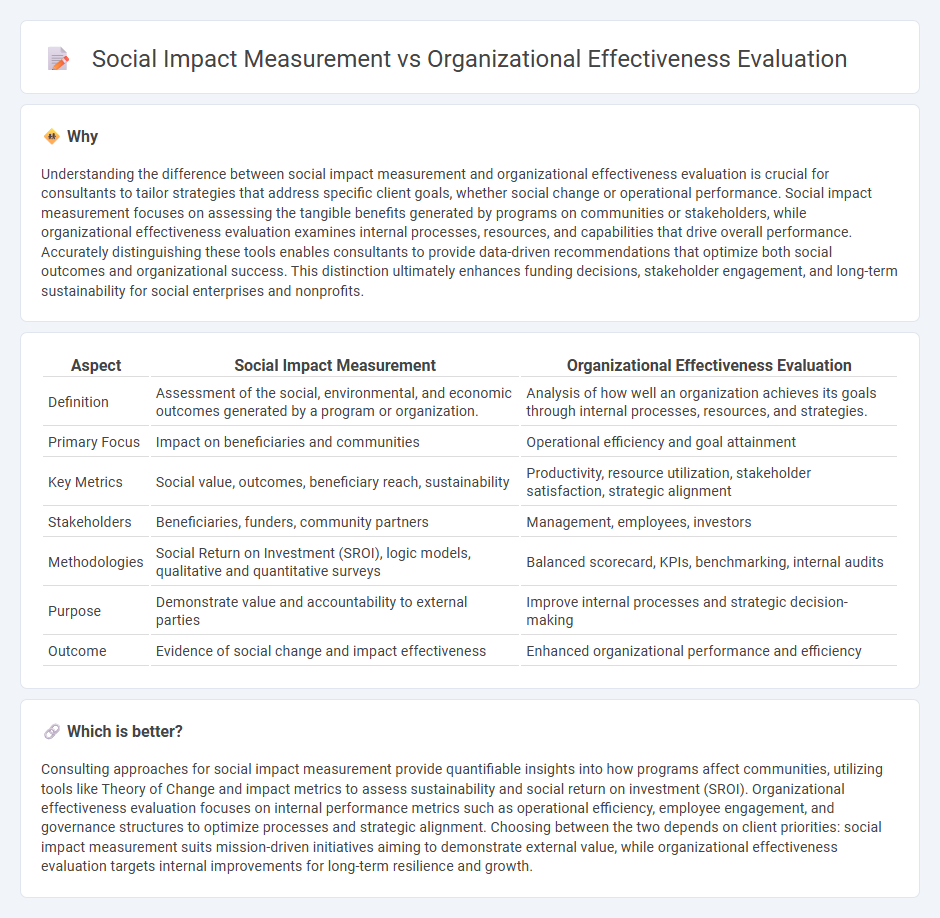
Consulting in social impact measurement focuses on quantifying the tangible benefits and societal changes resulting from programs, using metrics like social return on investment (SROI) and impact assessments. Organizational effectiveness evaluation assesses internal processes, leadership efficiency, and resource utilization to optimize performance and achieve strategic goals. Explore more to understand how these distinct approaches drive sustainable growth and accountability.
Why it is important
Understanding the difference between social impact measurement and organizational effectiveness evaluation is crucial for consultants to tailor strategies that address specific client goals, whether social change or operational performance. Social impact measurement focuses on assessing the tangible benefits generated by programs on communities or stakeholders, while organizational effectiveness evaluation examines internal processes, resources, and capabilities that drive overall performance. Accurately distinguishing these tools enables consultants to provide data-driven recommendations that optimize both social outcomes and organizational success. This distinction ultimately enhances funding decisions, stakeholder engagement, and long-term sustainability for social enterprises and nonprofits.
Comparison Table
| Aspect | Social Impact Measurement | Organizational Effectiveness Evaluation |
|---|---|---|
| Definition | Assessment of the social, environmental, and economic outcomes generated by a program or organization. | Analysis of how well an organization achieves its goals through internal processes, resources, and strategies. |
| Primary Focus | Impact on beneficiaries and communities | Operational efficiency and goal attainment |
| Key Metrics | Social value, outcomes, beneficiary reach, sustainability | Productivity, resource utilization, stakeholder satisfaction, strategic alignment |
| Stakeholders | Beneficiaries, funders, community partners | Management, employees, investors |
| Methodologies | Social Return on Investment (SROI), logic models, qualitative and quantitative surveys | Balanced scorecard, KPIs, benchmarking, internal audits |
| Purpose | Demonstrate value and accountability to external parties | Improve internal processes and strategic decision-making |
| Outcome | Evidence of social change and impact effectiveness | Enhanced organizational performance and efficiency |
Which is better?
Consulting approaches for social impact measurement provide quantifiable insights into how programs affect communities, utilizing tools like Theory of Change and impact metrics to assess sustainability and social return on investment (SROI). Organizational effectiveness evaluation focuses on internal performance metrics such as operational efficiency, employee engagement, and governance structures to optimize processes and strategic alignment. Choosing between the two depends on client priorities: social impact measurement suits mission-driven initiatives aiming to demonstrate external value, while organizational effectiveness evaluation targets internal improvements for long-term resilience and growth.
Connection
Social impact measurement provides quantifiable data on the outcomes of consulting initiatives, directly informing organizational effectiveness evaluation by highlighting areas of success and improvement. By integrating social impact metrics, organizations can align their strategic goals with measurable societal benefits, enhancing decision-making processes and resource allocation. This connection ensures that consulting efforts drive both operational efficiency and positive community outcomes, fostering sustainable growth and accountability.
Key Terms
Organizational effectiveness evaluation:
Organizational effectiveness evaluation assesses internal processes, resource utilization, and goal achievement to determine how well an organization operates and delivers value. It involves metrics such as productivity rates, employee engagement, and financial performance to optimize operational efficiency. Explore deeper insights into organizational effectiveness evaluation to enhance strategic planning and decision-making.
Key Performance Indicators (KPIs)
Organizational effectiveness evaluation centers on KPIs that track internal processes, resource utilization, and operational efficiency, reflecting how well an organization meets its strategic goals. Social impact measurement focuses on KPIs related to community benefits, social change outcomes, and long-term societal value, emphasizing external impact beyond financial metrics. Explore deeper insights into aligning these KPI frameworks to optimize both operational success and meaningful social contributions.
Benchmarking
Organizational effectiveness evaluation centers on assessing internal performance metrics such as operational efficiency, resource utilization, and goal achievement, while social impact measurement quantifies the broader societal outcomes generated by an organization's activities. Benchmarking in organizational effectiveness often involves comparing key performance indicators (KPIs) with industry standards, whereas social impact benchmarking evaluates social value creation against community and stakeholder expectations. Explore the latest methodologies and tools in benchmarking to enhance both organizational performance and social impact analysis.
Source and External Links
What is organizational effectiveness: Key factors to achieve it as a ... - Organizational effectiveness evaluation involves systematic assessments like surveys, performance metrics, SWOT analysis, interviews, benchmarking, and 360-degree feedback to measure how well an organization achieves its goals and operates efficiently.
Evaluating Organizational Effectiveness by Wesley A. Martz - This dissertation proposes an Organizational Effectiveness Evaluation Checklist (OEC), a structured framework validated through expert input and real-world application for comprehensive assessment of organizational merit and effectiveness.
Organizational Effectiveness Assessment(tm) - Chatsworth Consulting Group - The OEA is a thorough evaluation method that analyzes organizational culture, leadership, strategy implementation, communication, productivity, and stakeholder relations to diagnose underlying issues and guide long-term improvements.
 dowidth.com
dowidth.com